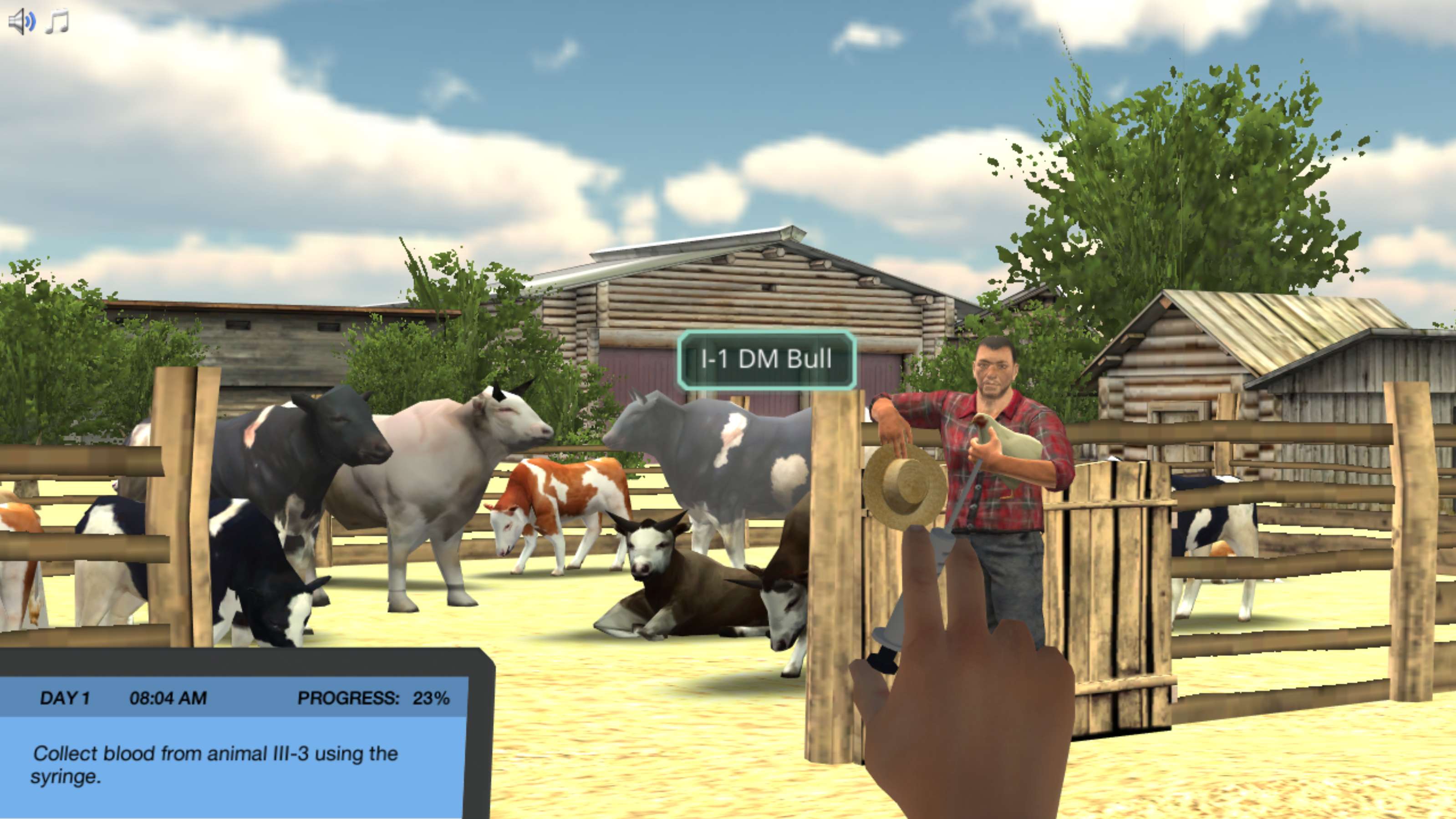Heading 1
Heading 2
Heading 3
Heading 4
Heading 5
Heading 6
Lorem ipsum dolor sit amet, consectetur adipiscing elit, sed do eiusmod tempor incididunt ut labore et dolore magna aliqua. Ut enim ad minim veniam, quis nostrud exercitation ullamco laboris nisi ut aliquip ex ea commodo consequat. Duis aute irure dolor in reprehenderit in voluptate velit esse cillum dolore eu fugiat nulla pariatur.
Block quote
Ordered list
- Item 1
- Item 2
- Item 3
Unordered list
- Item A
- Item B
- Item C
Bold text
Emphasis
Superscript
Subscript
About This Simulation
Learn about the Mendelian inheritance of double muscling in cattle. Find the responsible gene using linkage analysis and learn how mutation in this gene alters gene expression resulting in double muscled cattle.
Learning Objectives
- Explain different hereditary traits and modes of inheritance
- Construct a pedigree analysis based on observed phenotypes
- Perform genome scanning to identify candidate genes for double muscling in cattle
- Develop a DNA test for double muscling in cattle
About This Simulation
Lab Techniques
- Gel electrophoresis
- PCR
- Pedigree/ linkage analysis
Related Standards
- HS-LS3-1
- HS-LS3-2
- 5.4 Non-Mendelian Genetics
- 2.7 DNA replication, transcription and translation
Learn More About This Simulation
In the Animal Genetics simulation you will learn about Mendelian inheritance and how a mutation in DNA can give rise to an altered phenotype. You will use polymerase chain reaction (PCR) and gel electrophoresis to perform genotyping in order to identify the gene that causes double muscling in cattle.
Fill in the pedigree
As a researcher you will be called to a farm to investigate a case about double muscled cattle. In your first task you will fill in a pedigree to help identify the double muscled cattle. By studying the pedigree, you will learn about heritable traits and whether double muscling is autosomal or sex-linked and whether it is dominant or recessive. You will then draw a blood sample, and from that, extract DNA and perform further experiments in the lab.
Identify the candidate gene
Your next task will be to perform genome scanning, which involves an analysis of the entire genome and identifying the candidate gene by using short tandem repeats (STRs) as markers. By detecting STR patterns and similar gene sequences in double muscled cattle DNA, your goal will be to narrow down the genomic location of the candidate gene. Experimentally, this will be achieved by amplifying the STRs using PCR and analyzing the PCR product size using gel electrophoresis.
Develop a DNA test
After identifying the gene responsible for double muscling, your last task will be to develop a DNA test. This test will be used to determine the origin of organic meat; as it is prohibited to label meat as organic if derived from double muscled cattle. You will use your newly developed DNA test on three meat packages from an organic farm.
Will you be able to use your understanding of animal genetics to find the gene which causes double muscling and develop a reliable commercial test for organic meat?
For Science Programs Providing a Learning Advantage
Boost STEM Pass Rates
Boost Learning with Fun
75% of students show high engagement and improved grades with Labster
Discover Simulations That Match Your Syllabus
Easily bolster your learning objectives with relevant, interactive content
Place Students in the Shoes of Real Scientists
Practice a lab procedure or visualize theory through narrative-driven scenarios


FAQs
Find answers to frequently asked questions.
Heading 1
Heading 2
Heading 3
Heading 4
Heading 5
Heading 6
Lorem ipsum dolor sit amet, consectetur adipiscing elit, sed do eiusmod tempor incididunt ut labore et dolore magna aliqua. Ut enim ad minim veniam, quis nostrud exercitation ullamco laboris nisi ut aliquip ex ea commodo consequat. Duis aute irure dolor in reprehenderit in voluptate velit esse cillum dolore eu fugiat nulla pariatur.
Block quote
Ordered list
- Item 1
- Item 2
- Item 3
Unordered list
- Item A
- Item B
- Item C
Bold text
Emphasis
Superscript
Subscript
A Labster virtual lab is an interactive, multimedia assignment that students access right from their computers. Many Labster virtual labs prepare students for success in college by introducing foundational knowledge using multimedia visualizations that make it easier to understand complex concepts. Other Labster virtual labs prepare learners for careers in STEM labs by giving them realistic practice on lab techniques and procedures.
Labster’s virtual lab simulations are created by scientists and designed to maximize engagement and interactivity. Unlike watching a video or reading a textbook, Labster virtual labs are interactive. To make progress, students must think critically and solve a real-world problem. We believe that learning by doing makes STEM stick.
Yes, Labster is compatible with all major LMS (Learning Management Systems) including Blackboard, Canvas, D2L, Moodle, and many others. Students can access Labster like any other assignment. If your institution does not choose an LMS integration, students will log into Labster’s Course Manager once they have an account created. Your institution will decide which is the best access method.
Labster is available for purchase by instructors, faculty, and administrators at education institutions. Purchasing our starter package, Labster Explorer, can be done using a credit card if you are located in the USA, Canada, or Mexico. If you are outside of North America or are choosing a higher plan, please speak with a Labster sales representative. Compare plans.
Labster supports a wide range of STEM courses at the high school, college, and university level across fields in biology, chemistry, physics, and health sciences. You can identify topics for your courses by searching our Content Catalog.















